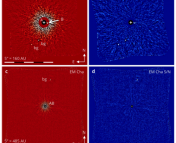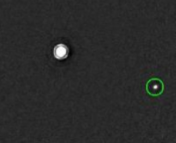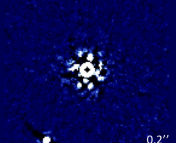Title: An imaged 15Mjup companion within a hierarchical quadruple system
Authors: A. Chomez, V. Squicciarini, A.-M. Lagrange, P. Delorme, G. Viswanath, M. Janson, O. Flasseur, G. Chauvin, M. Langlois, P. Rubini, S. Bergeon, D. Albert, M. Bonnefoy, S. Desidera, N. Engler, R. Gratton, T. Henning, E.E. Mamajek, G.-D. Marleau, M.R. Meyer, S. Reffert, S.C. Ringqvist, M. Samland
First Author’s Institution: Observatoire de Paris, Université PSL, CNRS, 5 Place Jules Janssen, 92190 Meudon, France
Status: Published on ArXiv, 3 July 2023. Accepted for publication as a letter in Astronomy and Astrophysics

The search for exoplanets and brown dwarfs (together called low-mass substellar companions) around stars that are more massive than 3 solar masses, has been a challenging task. Previous detections were sporadic and primarily relied on the radial velocity technique. Today’s authors sifted through archival data of the SPHERE high-contrast imager on the Very Large Telescope in Chile and found evidence for the existence of such a companion in an hierarchical quadruple system: The HIP 81208 system is the first binary stellar system discovered by direct imaging where both stars have a substellar companion, which raises intriguing questions about their formation.
An image of the HIP 81208 system is shown in Fig.1. The team supplemented archival SPHERE data and conducted an extensive analysis of the system using astrometric data obtained from the Gaia mission (see Fig.2 as well as this Astrobite for details on Gaia). Proper motion measurements of the companions, labeled B, C, and Cb, were compared to known background sources, confirming their common motion in the same direction and an orbit around the primary (labeled A). To further validate their findings, the team assessed the likelihood of a chance alignment with an unseen member of the Upper Centaurus-Lupus association that could be in the background, yielding a high confidence level for the membership of A (+B) and C (+Cb) to a single quadruple system.

The HIP 81208 system already stood out due to its very unique architecture. The primary star, a B-type star, is surrounded by a brown dwarf companion and an M-type stellar companion (C). Additionally, today’s authors report the discovery of the additional low-mass substellar companion, Cb, with a mass estimate of 14.8 ± 0.4 Jupiter masses (MJup), that orbits C. These findings make the HIP 81208 system the first binary system ever discovered by direct imaging with substellar companions to both components.
While the new found companion Cb’s orbital properties are poorly constrained, it seems to be around 20 au away from C. This would locate Cb closer to its host star than any other systems with comparable mass ratios that were discovered as seen in Fig.3.
The remarkable architecture of HIP 81208 Cb and the entire quadruple system raises questions about possible formation pathways (see this Astrobite for a similar discussion).
One potential scenario is the turbulent fragmentation of a star-forming core, possibly followed by inward migration. In this case, the circumstellar disks of A and C would be truncated due to mutual gravitational interactions. The truncation radii for the two stars were estimated, with C at 26 ± 9 au and A at 130 ± 40 au, and indeed, the current position of Cb appears to be marginally within the locations of its alleged parent disk. While this suggests that A and C may have formed via turbulent fragmentation, core accretion models do not predict the formation of a high mass ratio, 15 MJup object around a late M-type star, primarily due to formation timescales exceeding typical disk lifetimes, thus rendering the formation of Cb challenging.

Alternatively, gravitational instability within the disk of HIP 81208 A could represent a formation channel for Cb. This scenario would require an unusually large disk-to-star ratio of approximately 30% (around 40 MJup) compared to the expected 1-10% range. Notably, the separation between C and Cb falls within the typical range of M-type stellar binaries. Another intriguing possibility is that C itself formed via gravitational instability within the disk of A. While simulations have shown the production of objects with masses as high as 0.12 solar masses around stars less than 1.2 solar masses, there is a lack of gravitational instability models suited to B-type hosts. Nonetheless, observed circumstellar disks around early B-type stars spanning hundreds of au provide tantalizing hints.
The discovery of a low-mass substellar companion, Cb, in the HIP 81208 system, adds to its already unique architecture, and thus challenges our current understanding of companion formation around massive stars. Further observations will continue adding necessary data points that advance our understanding of the formation of stellar and planetary systems. Maybe, HIP 81208 itself still has another family member to reveal…
Astrobite edited by William Balmer
Featured image credit: DreamStudio by stability.ai using the prompt “An image of a binary star system in space. Each star has a brown dwarf around it. The title should be: The First Directly Imaged Binary System with Substellar Siblings”





There is an apparent distance scale “as____” in Figure 1. What does the “as” stand for?
Thanks for your comment. ‘as’ is short for arcsecond, a unit for the angle on the sky. The entire system is about 148 parsec away, so at that distance, 1 arcsecond conveniently corresponds to exactly 148 Astronomical Units, i.e. the distance between Earth and the Sun. For reference, the binary star C orbits A at a distance of about 230 AU.